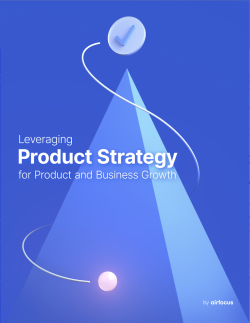Top-down Product Strategy
What is a top-down product strategy?
Definition of top-down product strategy
A top-down product strategy is a hierarchy, where leaders and decision-makers pass information and instruction down to the product manager regarding the outcomes of the product. This strategy may be flexible in some cases whereby decision-makers, senior management, and the product manager, all interact to design the strategy.
Introduction to top-down strategy
In the field of business and management, top-down strategy refers to a method of decision-making that begins at the top level of an organization and flows down to lower-level employees.
A top-down strategy involves setting overall goals and objectives at the executive level and then communicating them down the chain of command. This type of strategy is often the default in an organization.
This technique is often used in larger companies with complex management structures. It's also common with early-stage startups, where product managers are appointed to implement various tasks beyond product discovery.
Constituents of a top-down product strategy
A product strategy may contain features such as a vision, objectives, and initiative. The vision acts as the inspiration and sits on top of the strategy. The objectives provide a means by which to measure progress, such as performance indicators. The initiative proposes a product to be built or a problem to be overcome.
Why is a top-down strategy important in product development and product management?
A top-down product strategy helps ensure everyone in an organization is on the same page and working towards a common goal. It allows for more efficient decision-making and execution, allowing for quicker results.
With product management specifically, the top-down approach allows for more efficient product development and delivery. It helps ensure product goals are clear and actionable and provides for a more focused development process.
A top-down marketing strategy
A top-down strategy is important not just for product development but also for marketing. Having a clear and concise vision of what the company wants to achieve makes it easier for marketing teams to create campaigns designed to reach those goals.
Advantages and Disadvantages of Top-Down Strategy
Advantages:
Makes it easy to articulate the product vision to all stakeholders. Having a clear and concise product vision under a top-down approach makes it easier for everyone in the organization to understand what needs to be done.
Helps you build your roadmap. A top-down strategy helps you effectively build a roadmap with clear goals and objectives.
Helps with prioritization. It enables organizations to identify priorities and not focus on items that don't serve the product vision.
More efficient. A top-down approach allows for quicker decision-making and execution. This improves efficiencies throughout product development and product management.
Disadvantages:
Not as flexible. Since decisions are made from the top, it can be challenging to be flexible and adjust quickly to changing conditions throughout product development.
Less employee engagement. With a top-down strategy, there is less employee engagement and ownership of the product. It can leave employees with the mindset that their opinions don't matter.
Fewer chances to give feedback to management/powerful stakeholders. A top-down approach can mean a lack of feedback or input from lower-level employees. This can leave them feeling excluded like they’re not part of the decision-making process.
Top-down vs. bottom-up strategies
In a top-down approach, the problem is viewed as a whole and then broken down into smaller parts, making it easier to understand and solve.
Bottom-up, however, starts from the individual components and works up to the big picture. With a bottom-up strategy, all company levels are empowered, while a top-down strategy puts the power in the hands of managers and executives.
Both strategies have advantages and disadvantages in product development and product management. A top-down approach is great for setting overall goals and objectives, while a bottom-up strategy allows for more flexibility throughout the process.
Top-down marketing strategy versus bottom-up marketing strategy
A top-down marketing strategy is built around setting the organization's marketing goals and creating a roadmap to achieve them. With this strategy, a marketing initiative will move from the top of the pyramid to lower levels.
In a bottom-up marketing strategy, you engage with customers to develop a product or service that is aligned with their needs.
Top-down product strategy example — Apple
Apple's product strategy is a prime example of how a top-down product strategy can help a company successfully dominate a market. While co-founder Steve Jobs was chairman and CEO of Apple, the company's top executives drove the innovation and strategy, which then filtered down to the lower-level employees. Engineers then developed and delivered each of Apple’s.
Under Jobs' leadership, Apple had a clear company vision and product roadmap that was well-defined and controlled. This top-down strategy from Steve Jobs and the executive management included product design, features, user interface, and marketing. The result was a tightly controlled range of high-quality products with instantly recognizable branding.
This top-down approach also allowed Apple to firmly integrate its engineering and products with its marketing efforts. By doing so, they were able to build a strong brand through a marketing strategy that was clear and coherent.

General FAQ

Glossary categories
Create effective product strategy

Experience the new way of doing product management








